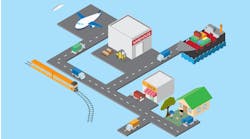The Fitch study notes that though railroads have added capacity through last year, it will be tight relative to demand through the new year. The reason is that “railroads have learned from their past mistakes and are now taking a measured approach to capacity growth, adding just enough to improve their operational integrity.” As with the trucking industry, rail wants to be careful not to expose itself to overcapacity issues if the economy should slow.
Further, Fitch notes, rail is, “keenly aware of the revenue benefits from limitations on capacity and, in some cases, is showing a willingness to turn away business that does not meet profit objectives.” At the same time, U.S. railroads are aware as well of a decline in performance and have taken steps to correct operational problems and improve network flow.
The study notes that Union Pacific, for example, is adding more than 700 locomotives and hiring 5,400 train and engineer employees. In addition to adding locomotives and hiring employees, CSX has created a new program, “ONE Plan” aimed at improving network flow and capacity through optimization of car routing. These two of the four U.S. Class I railroads experienced the greatest decline in average train velocities during 2004, as well as having “their cars spend increasing amounts of time parked in rail yards,” according to Fitch.
With natural gas prices remaining high, coal demands – representing 21% of volumes for the Class I’s – for use by electric utilities should be robust. Intermodal will remain strong based on the continued U.S. consumer demands for imported goods and foreign demand for exports.
As U.S. manufacturing continues to grow, so shipments of raw materials and finished goods are expected to remain as important drivers of rail business. The only area of business in which Fitch sees weakness, is 2005 auto shipments, with inventory questions for the domestic Big Three U.S manufacturers.
Though oil prices are expected to remain high through 2005, Fitch notes that BNSF, CSX and Norfolk Southern have all hedged a significant portion of anticipated needs for the year – the exception being Union Pacific. The Association of American Railroads does point out that the Fitch study notes that high fuel prices magnify cost differentials between rail and truck – the mode rail regards as its main competitor – and that it is likely that, “the trucking industry will contribute directly to higher rail revenue as it finds intermodal trains an increasingly cost effective way to move trailers and containers over long distances.”

